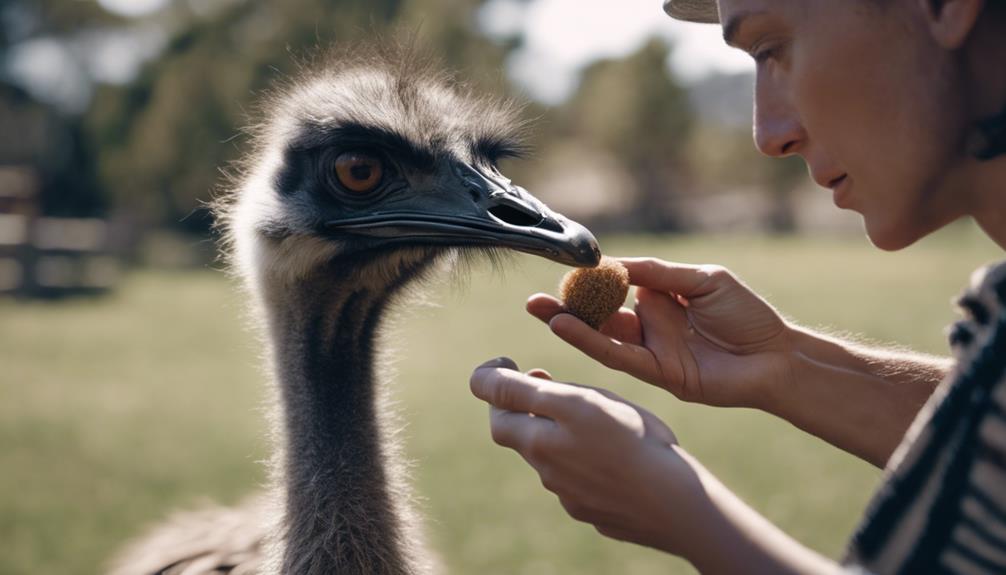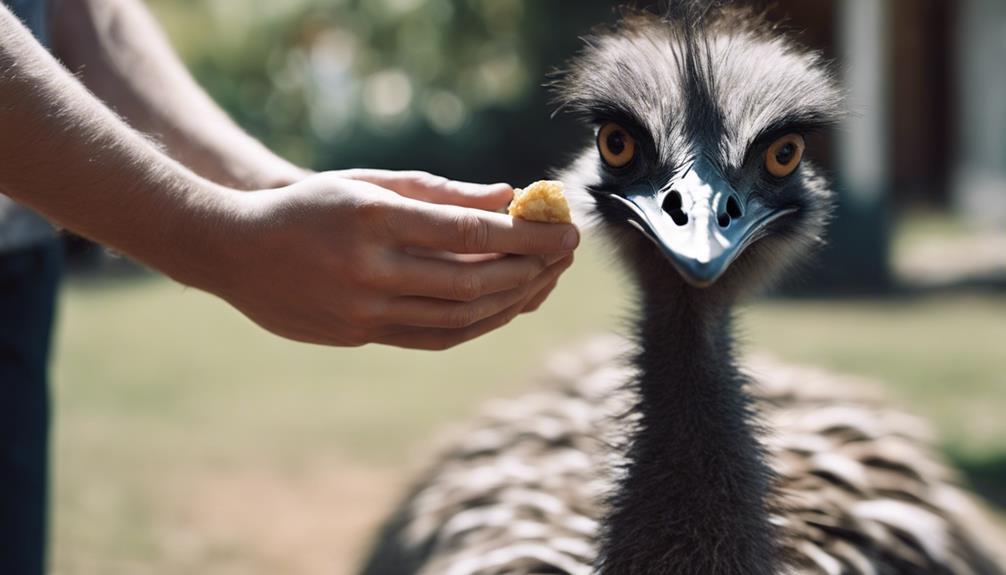
Imagine successfully training your emu to calmly walk alongside you during your daily strolls.
But what happens when your emu suddenly becomes stubborn and refuses to cooperate?
In this guide, we'll explore effective methods to train your emu, build a strong bond, and overcome common challenges that may arise.
Mastering the art of taming these majestic birds requires patience, consistency, and a deep understanding of their unique behaviors.
Key Takeaways
- Establish trust through consistent interactions and positive reinforcement.
- Understand emu behavior cues for effective communication and training.
- Create a safe environment with proper enclosure and predator-proofing.
- Utilize positive reinforcement techniques for shaping desired behaviors in emus.
Emu Training Basics

When training your emu, it's crucial to establish clear communication through consistent cues and positive reinforcement. Understanding your emu's feeding habits is essential for successful training. Emus are omnivores, so a diet of plants, insects, and small vertebrates is typical. Utilize their feeding times to your advantage during training sessions, as a hungry emu is more likely to be motivated to learn.
Emus communicate through various signals, including vocalizations, body language, and even their feather positioning. Pay close attention to how your emu responds to different cues and adjust your training methods accordingly. Positive reinforcement, such as offering favorite treats when desired behavior is exhibited, can help strengthen the bond between you and your emu.
Consistency is key when establishing communication with your emu. By being clear and predictable with your cues and rewards, you can create a trusting environment where your emu feels secure and willing to engage in training activities. Remember, patience and understanding of your emu's natural behaviors are fundamental to successful training outcomes.
Understanding Emu Behavior
To understand emu behavior effectively, observe their natural instincts and social interactions closely. Emus communicate using a variety of signals, such as vocalizations, body movements, and even changes in their feather positioning. Understanding these communication signals is crucial to deciphering their moods and intentions.
For instance, when an emu feels threatened, it may emit low-frequency booming sounds or puff up its feathers to appear larger and more intimidating. Paying attention to these cues can help you anticipate their reactions and respond accordingly.
Additionally, emus rely heavily on body language cues to convey their emotions and establish dominance within their social groups. They may use aggressive postures like fluffing up their feathers, lowering their necks, or pecking to assert dominance or express displeasure. Conversely, submissive behaviors such as crouching, avoiding eye contact, or softly clucking indicate deference or a desire to appease others.
Building Trust With Your Emu

Developing trust with your emu requires consistent and patient interaction, establishing a foundation of mutual understanding and respect. Emus are intelligent and perceptive creatures, quick to pick up on your emotions and intentions. To build rapport and communication with your emu, it's essential to approach interactions with a calm and steady demeanor. Emus respond well to routine, so consistency in your actions and behaviors is key to earning their trust.
Start by spending time near your emu, speaking softly and moving slowly to show that you mean no harm. Offer treats as a gesture of goodwill, always being mindful of your emu's body language to ensure you aren't overstepping any boundaries. Through gentle and patient interactions, your emu will begin to see you as a reliable and trustworthy presence in their environment.
Setting Up a Safe Environment
Establishing a secure and controlled environment is essential for successfully training and caring for your emu. To ensure the safety and well-being of your feathered friend, follow these expert tips:
- Emu Enclosure: Construct a spacious and sturdy enclosure that allows your emu to move freely.
- Predator Proofing Strategies: Implement predator-proofing measures such as burying wire mesh underground to prevent burrowing predators.
- Secure Fencing: Use high-quality fencing at least 6 feet tall to prevent your emu from escaping.
- Shelter: Provide a shelter within the enclosure to protect your emu from harsh weather conditions.
- Safe Flooring: Opt for soft and non-slip flooring to prevent injuries to your emu's delicate feet.
Creating a safe environment for your emu not only ensures its physical safety but also promotes a sense of security essential for successful training. By paying attention to these key details, you can set the stage for a positive and enriching relationship with your emu.
Positive Reinforcement Techniques

When training your emu, utilize positive reinforcement techniques to effectively encourage desired behaviors and foster a strong bond with your feathered companion. Behavior modification is key in shaping your emu's actions. By using reinforcement strategies such as offering treats, praise, or affection when your emu displays the behavior you want, you're actively communicating what's expected. Emus, like many animals, respond well to positive reinforcement as it creates a clear link between their actions and a pleasant outcome.
To implement these techniques successfully, timing is crucial. Ensure that the reinforcement follows the desired behavior immediately to strengthen the association. Consistency is also paramount; be consistent in your rewards and praise to avoid confusion. Emus are intelligent creatures and will quickly learn to repeat behaviors that result in positive outcomes.
Establishing Boundaries and Consistency
To ensure effective training and a harmonious relationship with your emu, maintaining clear boundaries and consistency in your interactions is essential. Setting boundaries helps your emu understand what behavior is acceptable and what's not. Consistent training reinforces these boundaries and builds trust between you and your emu.
Here are five key tips for establishing boundaries and maintaining consistency in your training sessions:
- Establish Ground Rules: Clearly define rules and expectations from the beginning.
- Use Positive Reinforcement: Reward good behavior to encourage adherence to the set boundaries.
- Be Firm but Gentle: Enforce boundaries consistently, but always with a gentle approach.
- Practice Regular Training Sessions: Consistency is key, so schedule regular training sessions to reinforce boundaries.
- Monitor Progress: Keep track of your emu's behavior and adjust training techniques as needed to maintain consistency.
Socializing Your Emu

For optimal development and well-rounded behavior in your emu, engaging in proper socialization practices is paramount. Socializing your emu not only helps them feel more comfortable around other animals and humans but also aids in preventing aggressive behavior. Here are some expert tips to help you navigate the world of emu socialization:
| Emu Playdates | Socializing Strategies |
|---|---|
| Schedule regular playdates with other emus to promote social interaction and mimic natural behaviors. | Start socializing your emu from a young age to ensure they grow up accustomed to different environments and beings. |
| Monitor play sessions to ensure they remain safe and positive for all involved. | Use positive reinforcement techniques such as treats and verbal praise to encourage friendly interactions with other emus. |
| Rotate playmates to expose your emu to a variety of personalities and temperaments. | Gradually increase the duration of playdates to build your emu's social skills and confidence. |
Introducing Treats and Rewards
Introduce treats and rewards strategically to reinforce positive behavior and foster a strong bond with your emu. Treat training can be a powerful tool in shaping your emu's behavior and building trust.
Here are some expert tips to help you establish a rewarding relationship with your feathered friend:
- Choose High-Value Treats: Opt for treats that your emu adores, such as mealworms or fresh fruits, to increase motivation.
- Timing is Key: Deliver the treat immediately after the desired behavior to create a strong association between the action and the reward.
- Consistency is Crucial: Be consistent in rewarding good behavior to reinforce positive habits effectively.
- Mix Up the Rewards: Vary the types of treats to keep your emu engaged and excited about the training sessions.
- Monitor Portion Sizes: Adjust the treat sizes based on your emu's response to maintain a healthy balance in the reward system.
Training Emus to Follow Commands

Begin the training process by establishing clear and consistent commands for your emu to follow, ensuring effective communication and understanding between you and your feathered companion.
Emu obedience is best achieved through repetition and positive reinforcement. Start with simple commands like 'stay' or 'come,' using treats as rewards when your emu follows them correctly.
Consistency is key in emu training; use the same words and gestures each time to avoid confusion. Monitor your emu's training progress closely, celebrating small victories and remaining patient during setbacks.
Emus are intelligent birds that respond well to structured training routines. As your emu starts to grasp basic commands, gradually introduce more complex tasks to challenge and stimulate their minds.
Remember to always end training sessions on a positive note, reinforcing the bond between you and your emu. With dedication and persistence, you'll see significant improvements in your emu's obedience and overall behavior.
Handling and Grooming Tips
Establishing a consistent handling and grooming routine is essential for maintaining the health and well-being of your emu. Proper care not only ensures your emu's physical health but also strengthens the bond between you and your feathered companion.
Here are some expert handling and grooming tips to help you nurture a healthy relationship with your emu:
- Feather Care: Regularly check your emu's feathers for any signs of damage or parasites. Gently clean any soiled feathers to prevent infections.
- Handling Techniques: Approach your emu calmly and confidently. Use slow movements and speak in a soothing tone to avoid startling them.
- Bonding Exercises: Spend quality time with your emu to build trust. Offer treats and engage in positive interactions to create a strong bond.
- Grooming Routines: Trim your emu's nails regularly to prevent overgrowth and discomfort. Brushing their feathers can help distribute natural oils and keep their plumage healthy.
- Health Checks: Schedule routine check-ups with a vet to ensure your emu is in optimal health. Stay vigilant for any changes in behavior or appetite that may indicate underlying issues.
Troubleshooting Common Training Challenges

To address common training challenges with your emu effectively, analyze their behavior patterns and adjust your approach accordingly. Emus, like any animal, may present behavior modification needs or communication challenges during training. By understanding these challenges and implementing appropriate strategies, you can foster a successful training experience for both you and your emu.
Troubleshooting Common Training Challenges
To help you navigate through common training challenges with your emu, refer to the table below:
| Challenge | Description | Solution |
|---|---|---|
| Aggression | Emu displays aggressive behavior | Identify triggers, use positive reinforcement |
| Fearfulness | Emu is fearful or skittish | Slowly introduce stimuli, build trust |
| Stubbornness | Emu refuses to follow commands | Break tasks into smaller steps, be patient |
| Distraction | Emu easily gets distracted | Minimize distractions, use high-value treats |
| Vocalization | Emu excessively vocalizes | Determine cause, redirect focus |
Emu Enrichment Activities
When enriching your emu's environment, strategically incorporate engaging activities to stimulate their mental and physical well-being. Emus are intelligent creatures that thrive on stimulation and interaction. To provide your emu with a fulfilling environment, consider the following activities:
- Emu playtime ideas: Emus enjoy interactive toys that challenge their problem-solving skills and keep them engaged.
- Outdoor exploration: Emus love to explore the outdoors, so setting up a safe and secure space for them to roam and investigate can be highly enriching.
- Foraging activities: Hide treats or their favorite snacks around their enclosure to encourage natural foraging behavior and keep them mentally stimulated.
- Obstacle courses: Create simple obstacle courses with tunnels, ramps, and low hurdles to keep your emu physically active and mentally sharp.
- Social interactions: Emus are social animals, so arranging playdates with other emus or even introducing them to other friendly animals can provide valuable social enrichment.
Frequently Asked Questions
Can Emus Be Potty Trained Like Other Pets?
Yes, emus can be potty trained, but it presents challenges. Understanding emu bathroom habits is crucial. Consistent training, positive reinforcement, and patience are key. With dedication, you can successfully teach your emu proper bathroom etiquette, enhancing your bond.
How Do You Handle an Emu That Becomes Aggressive During Training?
When handling aggression in an emu during training, observe their body language for signs of distress. Use de-escalation techniques and positive reinforcement to redirect behavior. Consistency and patience are key to building trust and overcoming challenges.
Are There Any Specific Health Concerns to Consider When Training an Emu?
When training an emu, it's crucial to consider dietary considerations and exercise needs. Maintaining a balanced diet and providing ample space for physical activity will ensure your emu stays healthy and responsive during training sessions.
Can Emus Be Trained to Wear Harnesses or Other Equipment for Activities Like Walking on a Leash?
Yes, emus can be trained to wear harnesses and other equipment for activities like walking on a leash. It's essential to understand emu behavior and socialization to ensure successful training. Emu enrichment and exercise are vital for their well-being.
How Do You Train an Emu to Interact With Other Animals, Such as Dogs or Horses?
To train an emu to interact with other animals like dogs or horses, observe emu body language for signs of stress or comfort. Gradually introduce the emu to the animals, using positive reinforcement. Over time, animal socialization can lead to harmonious coexistence.
Conclusion
Congratulations on taking the first step in training your emu! By understanding their behavior, building trust, and using positive reinforcement techniques, you're well on your way to having a well-behaved and happy emu companion.
Remember to create a safe environment, practice handling and grooming, and offer enrichment activities to keep your emu stimulated and engaged.
With dedication and patience, you'll soon have a well-trained emu by your side, ready to follow your commands with precision and skill.


